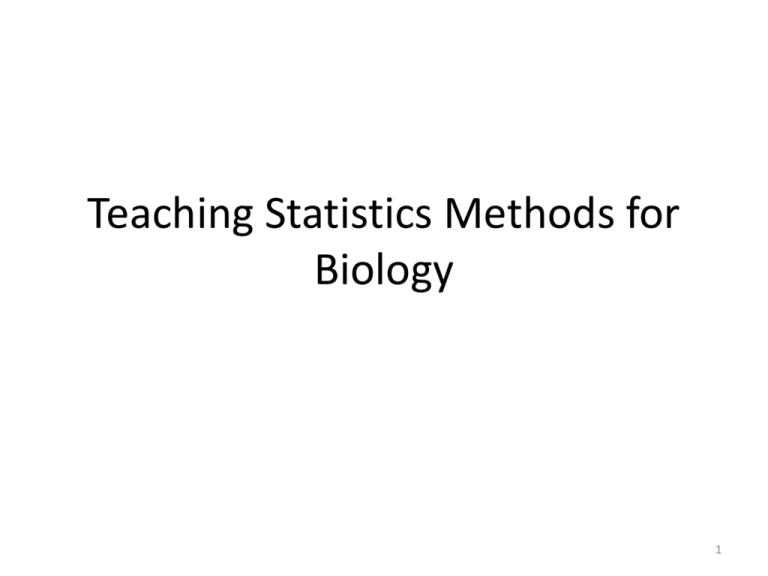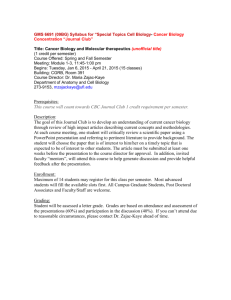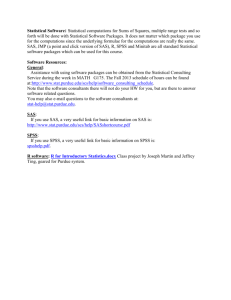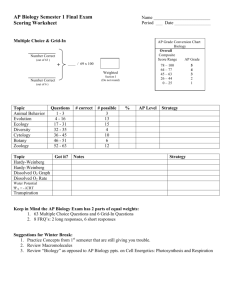Teaching Statistics Methods for Biology
advertisement

Teaching Statistics Methods for Biology 1 Outline • About stat 503 • Students • Course set up – Lecture – Project • Challenges • Teaching approach – Project design • Self-defined project • Instructor-defined project • More relevant project, collaboration with labs? – Method selection system – Class discussion tool • Clicker, Mixable and Hotseat 2 Stat 503— Statistical Methods for Biology • Semester: Fall, spring, summer. • Prerequisites/Corequisite: Mathematical experience at the level of one semester of calculus is required. • Primary Audience: Biology, pharmacy, some agriculture and health science. • Description: – Extensive coverage of statistical methods for mature students. – All examples and applications are drawn from the life, health and agricultural sciences. – Mathematical experience at the level of one semester of calculus is required, though no calculus is used in the course. 3 Student statistics(Fall, 2011) Level Major Sophomore 7% Graduate 30% Junior 30% Biochemistry, Botancy, Animal Science, Agronomy,Genetics, Ecological, Forestry, 46% Biology 54% Senior 33% 4 Student statistics(Fall, 2011) Experience Project 5% Expectation None 18% Statistics course 10% Statistical software 7% Interested in application 15% Understand statistical concept 60% None 85% 5 Lecture topic(Fall, 2011) • Basic summary statistics and graphs • Probability theory • Binomial distribution • Normal distribution • Central limit theorem • Sampling distribution • Experiment and sampling design • Confidence interval • • • • • • • Hypothesis test Nonparametric test One way ANOVA Two way ANOVA Multiple comparison Chi-square test Correlation and univariate linear regression 6 Project(Fall, 2011) • SAS – SAS codes demonstrated in class – SAS help session provided by the statistics department on Wednesdays. • Project – Running topic: health, living style and happiness. – Survey based, include data collection, analysis, and report. – Focus on problem set up and explanation. 7 Challenges • Motivation • Teaching statistical concept and notation – Example 1 • Teaching application – Example 2 • Project design • Attention 8 In the classroom • Lecture focuses on statistical concepts • Class activity – Monty hall – 17 points – Coke experiment – Hand-shaking experiment – Collaboration with labs? 9 Project • Project design – Ultimate goal: hand on experience on experiment design, data collection, data analysis and result presentation • Challenges – – – – Skill set, timeline and monitoring Experiment vs. observational study design Software Relevant/motivating topics ? • Successful cases – Self-defined projects (sum 2008) – Instructor-defined projects • Paper airplane contest • Happiness and GPA • Hotseat evaluation 10 Hotseat • Introducing Hotseat on Spring, 2011 • Role – As Clicker – As student support help session • www.purdue.edu/hotseat/login/login.aspx • More function development ? – Class question model • Question edit • Answer collection • Result presentation – Class discussion model • Student-initiated topic 11 Statistical consultant system • Direct method selection through a logic flow. • http://www.stat.purdue.edu/~tqin/statsys/sys tem101/system/main.htm 12







